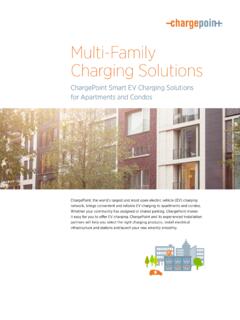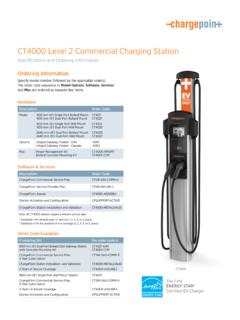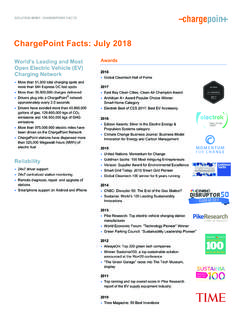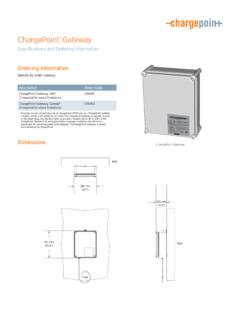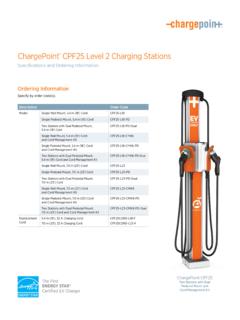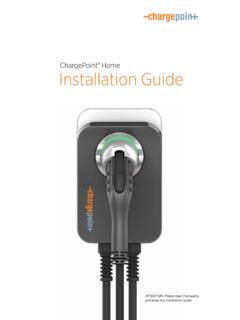Transcription of CT4000 Make-Ready Requirements Specification - EVSE
1 2016 ChargePoint, Inc. Page 1 of 14 CT4000 Make-Ready Requirements Specification Introduction This document provides best practices and guidelines for preparing a site to install EV charging stations ( Make-Ready ). Make-Ready means that all necessary electrical infrastructure to operate the charging stations, all conduit and wire is pulled to the station location(s), all concrete work is completed properly so the stations can be mounted and any cellular repeaters are installed if required. ChargePoint recommends that you plan for 5%-10% of parking spaces and 10%-15% for high EV adoption areas like California for future planning.
2 Consideration of electrical infrastructure that supports current and future needs for EV charging will help avoid costly upgrades later as demands for EV charging grows. Regardless of the specific type of CT4000 charging station you will be installing, these high level make ready Specification will be the same. ChargePoint recommends using a certified electrician to evaluate available capacity of existing electrical panels and to identify any electrical panel upgrades that may be required to support EV charging for multiple Make-Ready parking spaces. An onsite evaluation is necessary to determine conduit and wiring Requirements from panel to proposed Make-Ready parking spaces, as well as to measure cellular signal levels and identify suitable locations for placement of any necessary cellular signal booster equipment.
3 Station Location To help minimize costs you will want to choose station locations that are somewhat close to the available electrical infrastructure. In selecting these types of locations it helps minimize long conduit and wire runs as well as any trenching work. You should also consider locations where it will be easy to add future stations. You also need to ensure that station locations have strong 3G cellular connectivity to allow ChargePoint to communicate with the stations. If there is a weak signal at the station location a cellular signal booster (repeater) will need to be installed (See the Cellular Signal Levels section later in this document).
4 Finally, consider how easy the stations are to find for drivers needing to access them. EV Make-Ready Construction All construction must conform to all local codes that are designated by the state, local municipality or authorities of where you are performing the construction. Conduit and wire size will need to be determined based on the length of runs from electrical panel to the station location. The National Electrical Codes and local codes will help determine appropriate sizing. 2016 ChargePoint, Inc. Page 2 of 14 Each Level 2 charging port requires a dedicated single-phase electrical circuit (32A @ 208/240V) with 40A circuit breaker at the electrical panel.
5 A certified electrician must install all electrical circuits in accordance with local and National Electric Code Requirements . General guidelines for Make-Ready include: 1) Evaluation of existing electrical infrastructure to determine if there is sufficient existing utility service and electrical panel capacity and identify costs for any necessary upgrades and/or a new dedicated electrical panel. 2) For installation of dedicated EV electrical panel, choose panel location in close proximity to existing electrical supply. 3) Identify station locations for EV charging that are in close proximity to an electrical room with common area electrical panel; reduce distance for conduit runs and electrical wiring from electrical panel to all proposed EV parking spaces.
6 4) Determine the appropriate mounting location. 5) Ensure the wiring, circuit protection and metering is in place at the station installation location by reviewing the Specification , wiring diagram and grounding Requirements later in this document. 6) Ensure that you are using 6 or 8 gauge wire to station. If you will be feeding the station with larger wire like 4 gauge then you will need to splice the wire for 6 or 8 gauge. 7) If possible, avoid or minimize trenching Requirements , especially more costly trenching to run conduit under asphalt surfaces. 8) Choose adjacent parking spaces in an area with adequate lighting and identify suitable locations with flat surface for wall mount stations or suitable floor surface for pedestal mount stations (no asphalt surfaces).
7 9) Use dual-port pedestal mount stations where possible in open areas for adjacent or tandem parking spaces. 10) Determine optimum conduit layout to minimize linear conduit costs to multiple EV parking spaces and size all conduit and electrical wiring in accordance with National Electric Code Requirements . 11) Measure cellular signal levels for 3G Verizon and 3G AT&T carriers and identify optimum location for placement of ChargePoint gateway devices. 12) Ensure that adequate CDMA (Verizon, Sprint) or GSM (AT&T, Rogers) cellular coverage is available at the station installation location. To ensure adequate signal strength in underground or enclosed parking structures, cellular repeaters may be required.
8 (See the Cellular Signal Levels section later in this document) 13) For below ground-level or enclosed parking garages, installation of a cellular signal booster often is required with indoor antenna located near gateway device and EV parking spaces and outdoor antenna typically located at the garage entrance ceiling or on the rooftop where cellular signal levels are optimum. 14) Determine cost budget options for Make-Ready electrical infrastructure to satisfy current needs and future needs. Prioritize locations for installation of charging stations based upon immediate and future needs, construction timelines, and costs. For bollard mount charging stations, prepare the installation site by following the instructions in the Preparing Concrete Pad chapter.
9 The mounting template for the bollard can be found at Ensure the PDF version is accurate by printing it 2016 ChargePoint, Inc. Page 3 of 14 at 100% scale on 11 x 17 paper and then verify at least one dimension. (See also the Prepare the Installation Site for Bollard Mount later in this document) Review the CT4000 Data Sheet (available at ). It is recommended that only new 40A dual pole breakers are to be used. Used breakers can damage equipment and cause a fire risk. Always check local codes to ensure compliance. You may need to adjust this Specification to comply with codes that apply at your installation location.
10 If you have pre-existing infrastructure or are using your own preferred electrical contractor to prepare your site for charging, a Site Validation by a ChargePoint Operations and Maintenance (O&M) partner will be required to certify compliance with electrical Specification Requirements and to ensure that everything was prepared to ChargePoint specifications. Cellular Signal Levels ChargePoint charging stations communicate over the ChargePoint network via 3G cellular carriers to provide the following features to property managers and EV drivers: User authentication, access control, & billing Energy usage reporting Charging station utilization and charging session details for analytical reporting Real-time charging status to drivers using the ChargePoint mobile app or web portal Ability for drivers to start & stop charging sessions using the ChargePoint mobile app 24-hr driver support to remotely start charging sessions (ChargePoint cards also start & stop sessions)
